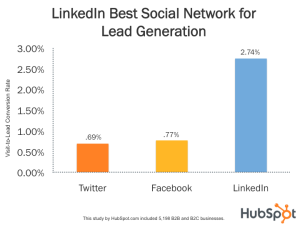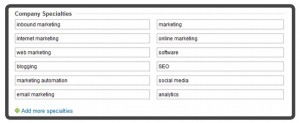LinkedIn: Pages Vs. Groups
For B2B companies, LinkedIn is one of the most powerful social media channels available. In fact, our Social Media research of more than 5,000 companies has shown that LinkedIn is 277% more effective at generating leads than Facebook and Twitter. But, with so many tools and micro-channels within LinkedIn, how do you make sure you’re getting the most out […]
For B2B companies, LinkedIn is one of the most powerful social media channels available. In fact, our Social Media research of more than 5,000 companies has shown that LinkedIn is 277% more effective at generating leads than Facebook and Twitter.
But, with so many tools and micro-channels within LinkedIn, how do you make sure you’re getting the most out of your efforts? When optimizing your company’s LinkedIn presence, it helps to know how to choose the right tool for the right job.

Should You Spend Time On Company Pages Or Groups?
Of the many ways to communicate on LinkedIn, company pages and groups are among the most popular. The trick is knowing which channel to use for what. In the sections below, I’ll go over each in detail, but here’s a top-level assessment of each.
Company Pages:
Your company page is the headquarters for all your products, reviews and basic organizational information. Because it is focused on your specific offerings, company pages tend to be further down the funnel in terms of content and information.
Think for a moment about the mindset of someone viewing your company page. They’ve made the specific choice to search for your company name and get details on what you do and sell. For this reason, you have a bit more freedom to talk about yourself. However, company pages typically have fewer views than groups, and so your posts won’t have the same reach.
Best content: Product releases, promotions, requests for feedback, new ebooks.
Groups:
When you’re just getting started, I’d suggest spending the bulk of your time sharing content to groups. While groups don’t specifically focus on your company, and don’t take well to promotional materials, they do tend to have a larger reach than company pages.
Added to the natural reach of groups is the fact that many groups automatically send an email digest to members with new posts. People join groups because they are interested in a topic, not a company. Make sure your posts are educational in nature or are discussion-prompts. Being too promotional in a group is not only ineffective; it can get you kicked-out.
Best content: Educational ebooks, targeted questions, new interesting data, infographics, etc.
How To Get The Most Out Of LinkedIn Pages
Set A Cover Photo:
With LinkedIn’s new updates, you have the ability to add a cover-style image that represents your company/brand at the top of your company overview page. Much like the image on your homepage, a cover photo is an opportunity to grab visitors’ attention. Don’t just use a logo – make your cover photo convey something about your company.
Search-Optimize Your Page:
Optimize your profile to get found by people searching LinkedIn. Use keywords that you think represent what your target audience would be searching for. Then add those keywords to various sections of your profile such as your headline or summary. You can include keywords in your company page’s summary section and in the “Company Specialties” section, seen below.

Post An Update To Your Followers (And Target Them!): As mentioned above, company status updates can range from new blog posts or downloadable content to promotions and company news. Experiment with different types of content to see which performs the best on your page. About 24 hours after you post an update you’ll be able to see each post’s impressions, clicks, and average engagement percentage.
You can even target your status updates to the activity feeds of specific users using LinkedIn’s targeting options. You can target your company updates by criteria like company size, industry, job function, seniority, geography, or by including/excluding company employees.
According to an internal LinkedIn study, some companies have seen a 66%+ increase in audience engagement as the result of targeted updates.

List Your Products Or Services (And Target Them!):
One of the main benefits of a company page over groups and answers is the ability to detail your products and garner reviews for each. The products section of your company page also provides an opportunity for lead generation with its call-to-action capabilities.
Each page has a giant, clickable cover image that can link to a product, service, or offer. Beneath this call-to-action are trusted recommendations from fans and recognizable connections. Use these recommendations within your own marketing and encourage happy customers to share their experiences there.
A Little Known Secret About Products:
LinkedIn also can target your products page to different segments based on characteristics in user profiles. For example, you can create a version targeted to the U.S. and a different version targeted to Europe. Start by creating a default version, then create different versions by clicking “New Audience.” Name your target, choose your targeting characteristics and click Save and Exit to edit your targeted page.
How To Get The Most Out Of LinkedIn Groups
Join Before Managing:
Groups are an oft-overlooked channel in LinkedIn. Leveraged correctly, however, they can give you a level of reach and engagement that you can’t find in other parts of LinkedIn. Before you manage a LinkedIn group, I’d suggest joining existing groups with already thriving memberships.
Managing successful groups takes a ton of work, both in growing membership and in keeping activity levels high. For most businesses it makes more sense to add value to an online community rather than reinvent the wheel.
There are two ways to find groups that matter to your business:
- Use the main search box in the upper right corner of LinkedIn to search for keywords
- Search for skills that are related to your work; the skills page can not only help you find new connections, it shows you a list of relevant groups to join
Join Complementary Groups:
It can be helpful to join groups within your industry, but also think about joining groups that your customers would join. By stretching out a little bit, you can find the people who matter most to your business. So, for example, if you’re an accountant, you don’t want to just join accounting groups — you’ll want to join groups for entrepreneurs, small business owners and other groups outside of your immediate circle.
Use A Social Media Scheduler To Scale Your Efforts: Ask marketers about social media, and a common refrain is: where do people find the time? As social media has evolved and become a mainstay in communications, a number of tools have also evolved to help streamline and scale social efforts.
When it comes to social media, think first and foremost about the audience you’re targeting. What content would interest them? Where can they be found? When you have a piece of content or a discussion point worth sharing with your larger audience, use a scheduler to help deliver that content to the groups and forums where your audience resides.
In the example below, I’ve decided to share a piece of content with some of our HubSpot User Groups. Below, you’ll see I’ve chosen a piece of content to share with multiple HubSpot User Groups on LinkedIn at once. Sharing it with the groups ensures that it will have more activity than a simple company page post. As people respond, I can consolidate and track that activity within my social media publishing tool and follow up as needed.

Where To Start
There are countless opportunities to leverage LinkedIn to expand your reach and develop your expertise. But, everyone needs a starting point. To begin, take an afternoon to perfect your company page. Think about the mentality of someone who has actively sought out your company and the information they need at hand.
Next, spend a week finding and engaging in good groups for your company. Start by commenting on other posts, then in the following week, experiment with some posts of your own. Use a social media tool to streamline this effort and help you track its results.
From there, see what works and scale it up. As with most marketing, you’ll pick up nuances and best practices along the way.
Contributing authors are invited to create content for MarTech and are chosen for their expertise and contribution to the search community. Our contributors work under the oversight of the editorial staff and contributions are checked for quality and relevance to our readers. MarTech is owned by Semrush. Contributor was not asked to make any direct or indirect mentions of Semrush. The opinions they express are their own.
Related stories